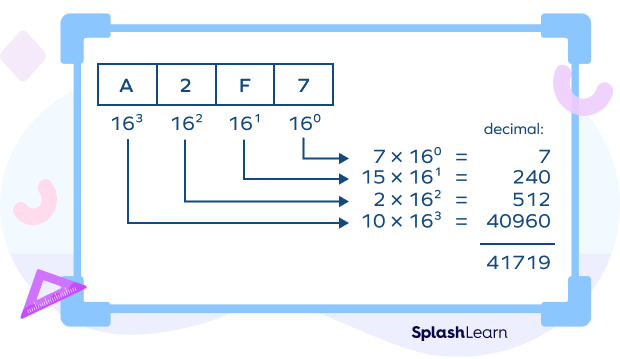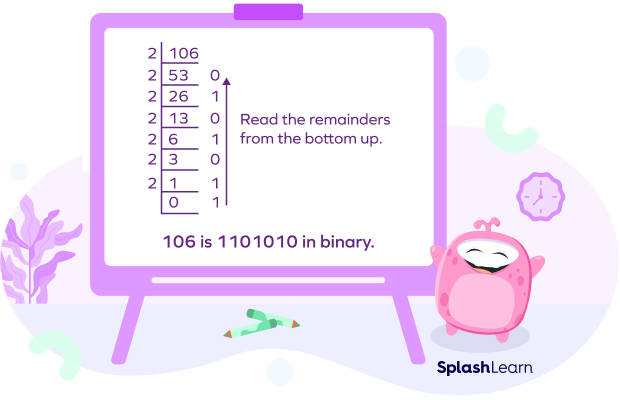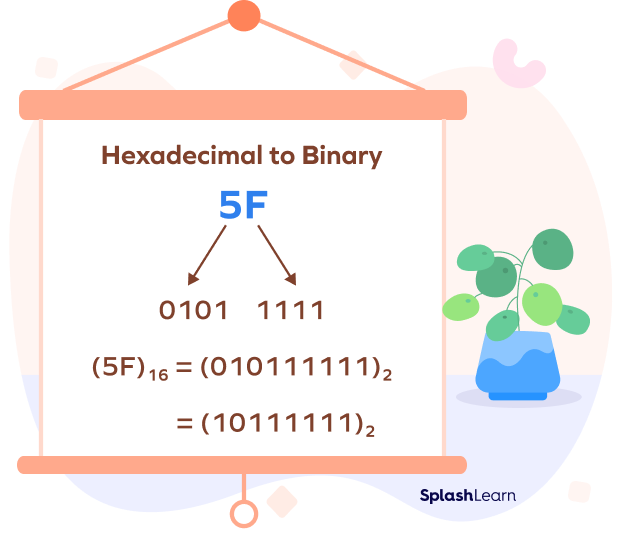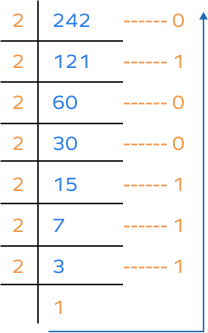What Is the Hexadecimal to Binary Conversion?
Hexadecimal to binary conversion refers to finding the binary equivalent of a hexadecimal number. It is a conversion from base-16 number system to base-2 number system.
We know that the decimal number system with base = 10 is the most commonly used number system. Let’s get to know about the hexadecimal and binary number systems.
What is a Hexadecimal Number System?
The base of a hexadecimal system is 16. It used 16 symbols given by 0, 1, 2, 3, 4, 5, 6, 7, 8, 9, A, B, C, D, E, F to represent all the numbers. To represent the numbers 0-9, we simply use the same digits. To represent 10-15, we use the letters A-F.
The place values in the hexadecimal number system are expressed in terms of powers of 16.
What is a binary decimal system?
The base of a binary system is 2. The binary numbering system uses two digits, 0 and 1, to represent all the numbers. Binary digits 0 and 1 are also called bits.
The place values in the binary number system are expressed in terms of powers of 2.
Hexadecimal to Binary Conversion Table
Here’s the hexadecimal to binary chart for quick conversions.
| Decimal | Hexadecimal | Binary |
|---|---|---|
| 0 | 0 | 00000000 |
| 1 | 1 | 00000001 |
| 2 | 2 | 00000010 |
| 3 | 3 | 00000011 |
| 4 | 4 | 00000100 |
| 5 | 5 | 00000101 |
| 6 | 6 | 00000110 |
| 7 | 7 | 00000111 |
| 8 | 8 | 00001000 |
| 9 | 9 | 00001001 |
| 10 | A | 00001010 |
| 11 | B | 00001011 |
| 12 | C | 00001100 |
| 13 | D | 00001101 |
| 14 | E | 00001110 |
| 15 | F | 00001111 |
How to Convert from Hexadecimal to Binary
There are different ways to convert a binary number into a hexadecimal number. Either we can convert using direct methods or indirect methods.
Method 1: Hexadecimal to decimal followed by decimal to binary
Method 2: Hexadecimal to binary direct conversion
Method 1: Indirect Method
First, we convert a binary into the decimal system, and then we convert it to a hexadecimal number.
- Hexadecimal to Decimal: To convert from hexadecimal to decimal, multiply each digit by its respective place value, and finally add the products.
- Decimal to Binary: To convert from decimal to binary, divide the decimal number by 2 repeatedly, until the quotient is 0.
Example 1: (A2F7)16

Example 2: Convert from hexadecimal to Binary: (6A)16
Hex to decimal: Here, A = 10
$(6A)_{16} = 6 \times 16^{1} + 10 \times 16^{0}$
$(6A)_{16} = 96 + 10$
$(6A)_{16} = 106_{10}$
Decimal to binary:

Thus, (6A)16 = 10610 = (1101010)2
Method 2: Direct Method: Hexadecimal to Binary Using Grouping and Conversion Table
There are only 16 digits from 0 to 7 and A to F in the hexadecimal number system, so we can represent any digit of the hexadecimal number system using only 4 bits as follows below.
Step 1: Divide the given hexadecimal number into individual digits.
Step 2: Assign binary equivalents to each hexadecimal digit. It’s important to keep track of leading zeros when converting hexadecimal to binary to maintain the correct number of digits.
| Hexa | 0 | 1 | 2 | 3 | 4 | 5 | 6 | 7 |
| Binary | 0000 | 0001 | 0010 | 0011 | 0100 | 0101 | 0110 | 0111 |
| Hexa | 8 | 9 | A | B | C | D | E | F |
| Binary | 1000 | 1001 | 1010 | 1011 | 1100 | 1101 | 1110 | 1111 |
Step 3: Replace each hexadecimal digit with its binary equivalent using the conversion table.
Example: Let’s convert the hexadecimal number “2A” to binary:
“2” in hexadecimal is equivalent to “0010” in binary.
“A” in hexadecimal is equivalent to “1010” in binary.
Therefore, “2A” in hexadecimal is equivalent to “00101010” in binary.

Hexadecimal to Binary Conversion Involving Hexadecimal Point
We can convert a hexadecimal number with a hexadecimal point to the binary system using the conversion table.
Example: Convert (0.A35)16 to binary.
Find the binary equivalent of each digit using the conversion table.
A16 = 10102
316 = 00112
516 = 01012
(0.A35)16 = (0.101000110101)2
Facts about Hexadecimal to Binary Conversion
- Each hexadecimal digit represents a group of 4 binary bits, making it a more compact representation of binary numbers.
- Hexadecimal to binary conversion involves converting each hexadecimal digit into its corresponding 4-bit binary representation.
- Hexadecimal system is particularly useful in computer systems, as it allows for easier readability and more concise representation of large binary numbers.
Conclusion
In this article, we learned about the hexadecimal to binary conversion and two methods to convert a hexadecimal number into binary. Let’s solve a few examples and practice problems to check your understanding.
Solved Examples on Hexadecimal to Binary Conversion
1. Convert (0B)16 into a hexadecimal number system by direct method.
Solution:
“0” in hexadecimal is equivalent to “0000” in binary.
“A” in hexadecimal is equivalent to “1010” in binary.
So, (0B)16 = (00001011)2
2. What is the value of (F2)16 into a hexadecimal number system using the indirect method?
Solution:
Hexadecimal to binary:
Here, F = 15
$(F2)_{16} = (15 \times 16^{1}) + (2 \times 16^{0})$
$(F2)^{16} = (15 \times 16) + (2 \times 1)$
$(F2)_{16} = 240 + 2$
$(F2)_{16} = 242_{10}$
Decimal to binary:

Thus, (F2)16 = 24210 = (11110010)2
3. Convert (DE)16 into the binary number system.
Solution:
D16 = 11012
E16 = 11102
So, (11011110)2 = (DE)16
Practice Problems on Hexadecimal to Binary Conversion
Convert Hexadecimal To Binary – Definition, Table, Examples, FAQs
Convert $(F5)_{16}$ from the hexadecimal number system to the binary system.
$F_{16} = 1111_{2}$ and $5_{16} = 0101_{2}$
$(F5)_{16} = (11110101)_{2}$
What is the value of $(7B)_{16}$ in the number system?
$7_{16} = 0111_{2}$ and $B_{16} = 1011_{2}$
$(7B)_{16} = (01111011)_{2}$
Convert $(A9)_{16}$ into the binary number system.
$1010_{2} = A_{16}$ and $100_{12} = 9_{16}$
So, $(10101001)_{2} = (A9)_{16}$
Frequently Asked Questions about Hexadecimal to Binary Conversion
Can I convert a hexadecimal number to binary manually?
Yes, you can manually convert a hexadecimal number to binary by substituting each hexadecimal digit with its corresponding 4-bit binary representation. However, for larger numbers, this process can become cumbersome. It is often more convenient to use online converters, calculators, or programming tools that automate the conversion process.
How do you convert decimal to hexadecimal?
Divide the decimal number by 16 repeatedly, till you get the quotient value equal to zero. Write the values of the remainder’s left in the reverse order to get the hexadecimal numbers.
How do you convert binary to hexadecimal?
The process of converting binary to hexadecimal is the reverse of converting hexadecimal to binary. Binary digits are grouped into sets of four, and each group is converted to its corresponding hexadecimal digit. This process allows for easier representation and manipulation of binary numbers in a hexadecimal format.
















